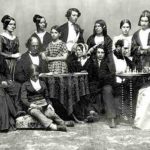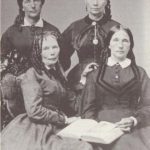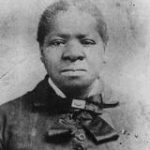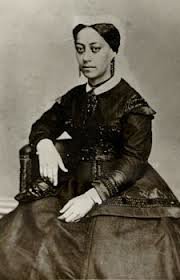Abolitionist and Fugitive Slave from Georgia
 Ellen Craft was a slave from Macon, Georgia who escaped to the North in 1848. Craft, the light-skinned daughter of a mulatto slave and her white master, disguised herself as a white male planter. Her husband William Craft accompanied her, posing as her personal servant. She traveled openly by train and steamboat, arriving in Philadelphia on Christmas Day 1848. Her daring escape was widely publicized, and she became one of the most famous fugitive slaves.
Ellen Craft was a slave from Macon, Georgia who escaped to the North in 1848. Craft, the light-skinned daughter of a mulatto slave and her white master, disguised herself as a white male planter. Her husband William Craft accompanied her, posing as her personal servant. She traveled openly by train and steamboat, arriving in Philadelphia on Christmas Day 1848. Her daring escape was widely publicized, and she became one of the most famous fugitive slaves.
Ellen Smith was born in 1826 in Clinton, Georgia, to a biracial slave woman named Maria and her white master, Colonel James Smith. Ellen was so light-skinned that she was often mistaken for a member of her father’s family. This infuriated Mrs. Smith so much that she gave Ellen, then 11 years old, to her daughter, the wife of Dr. Robert Collins of Macon, Georgia.
In Macon, Ellen met William Craft, a slave whose family had been sold to pay off his master’s gambling debts. At that time William belonged to a banker who apprenticed him out as a carpenter to a white cabinetmaker, an occupation that provided William with a trade few slaves were fortunate to obtain. Slaves who learned a trade had some autonomy, and many were allowed to keep part of their earnings.
Ellen and William were allowed to marry in 1846, but were not permitted to live together since they belonged to different owners. They endured this separation for a while but soon began to plan their escape from bondage.
The Escape
Ellen Craft cut her hair short, learned to walk like a man, and wrapped her jaw in bandages to disguise her lack of a beard. Dressed in trousers and a top hat, she posed as a white slaveholder traveling north with his slave for medical care. She also wrapped her right arm in a sling to hide the fact that she could not write.
On December 21, 1848, after obtaining passes from their masters to travel to the next town for the Christmas holiday, the couple used the money William had saved to board a train to Savannah. After traveling by steamboat along the coasts of South Carolina, North Carolina, Virginia and Maryland, the Crafts arrived in Philadelphia on Christmas Day, without being discovered.
After spending three weeks with a Quaker family, the Crafts moved on to Boston, the center of the abolitionist movement. William found a job as a cabinetmaker, and Ellen worked as a seamstress. They lived at the home of Lewis Hayden, who was an ex-slave and an abolitionist. His boarding house often served as a station on the Underground Railroad.
During the following years, the Crafts became active in the abolitionist movement and gained fame on the lecture circuit, where they quickly won the hearts of audiences with the romantic tale of their escape. Stories about them were published in The New York Herald, The Boston Globe and The Macon Telegraph, but that publicity would be their downfall.
In September 1850, Congress passed the Fugitive Slave Law, which made it a crime for residents of free states to harbor or aid fugitives like the Crafts and mandated the assistance of federal marshals and private citizens in the fugitives’ capture. The act also handsomely rewarded officers of the law for assisting slave owners by apprehending their runaways and sending them back into slavery.
The abolitionists in Boston responded by organizing a group they called the League of Freedom to protect fugitive slaves. This group elected Lewis Hayden president and William Craft vice-president. Ten days later, the League of Freedom was absorbed into the Boston Vigilance Committee, designed “to secure the colored inhabitants of Boston from any invasion of their rights.”
Ellen’s former owner, Dr. Robert Collins, sent two bounty hunters, Willis Hughes and John Knight, to Boston to return her to slavery. The Vigilance Committee transported Ellen to a safe place. William remained in the Hayden home, which Hayden turned into a veritable fortress, vowing to blow up his entire residence rather than surrender a single fugitive within his care.
Members of the Vigilance Committee harassed Hughes and Knight. They approached them at their hotel and told them that they would not be safe if they remained in Boston any longer. The slave catchers immediately left the city, but the warrant for the Crafts’ arrest was still in the hands of the Federal Marshal. They no longer felt safe, not even in the North.
With the assurance that they would be provided for in Liverpool, the Crafts sailed for England in November 1850. Working with antislavery organizations there, William and Ellen continued to contribute to the cause of emancipation. They remained public figures by lecturing in England and Scotland.
Running a Thousand Miles for Freedom, William Craft’s autobiography, was published in London in 1860. In his narrative, he stated: “It is true, our condition as slaves was not by any means the worst; but the thought that we could not call the bones and sinews that God gave us our own haunted us for years.”
In June 1851, the Crafts staged a demonstration against American slavery at the London Great Exhibition. They strolled through the American section with white abolitionist friends to demonstrate the irony of encountering more racial tolerance in England – a country that had banned slavery from its colonies by 1838 – than in the ‘democratic’ United States.
When visitors from the America spread rumors of Ellen’s desire to return to the security of her former home in Georgia, she responded: “I had much rather starve in England, a free woman, than to be a slave for the best man that ever breathed upon the American continent.”
William and Ellen lived in England for seventeen years. They attended an agricultural school in Surrey for three years, eventually teaching. They were offered the positions of superintendent and matron of the school, but they chose to settle in West London to raise their family of five children: Charles, William, Brougham, Alfred and Ellen.
Once the Civil War was over and all slaves were emancipated, the Crafts returned to the United States. After reunions in Boston, they settled in Ways Station, Georgia, near Savannah, in 1870.
There they raised money from northern publishers and antislavery friends to purchase 1800 acres of land.
On that property, they established the Woodville Cooperative Farm School in 1873, for the education and employment of former slaves, rescuing them from the contract labor system. They also opened a school for their children. The Ku Klux Klan burned out their first building.
Scandal erupted in 1876, when some of William’s investors accused him of using funds intended for charitable purposes for his own gain. He sued for libel to clear his name in Boston’s courts, but in 1878 lost the case along with many longtime allies.
The Woodville school, where Ellen was teaching 75 children free of charge, was forced to close due to lack of funding. William struggled to maintain the farm in spite of mounting debts, sinking cotton prices and increasing anti-black violence, but it soon failed.
In 1890, the Crafts moved to Charleston and lived with their daughter’s family. Ellen died in 1891, and at her request, was buried under her favorite tree on their land. In 1900, the farm they had established was auctioned off to pay William’s debts. He died one month later.
Although her efforts failed and she died in poverty, Ellen Craft deserves to be remembered for her belief in the dignity and worth of all human beings, and her determination to create a better life for future generations.
Ellen Craft was elected a ‘Georgia Woman of Achievement’ at the Fifth Induction Ceremony in Macon, Georgia on March 21, 1996.
She would be so proud!





